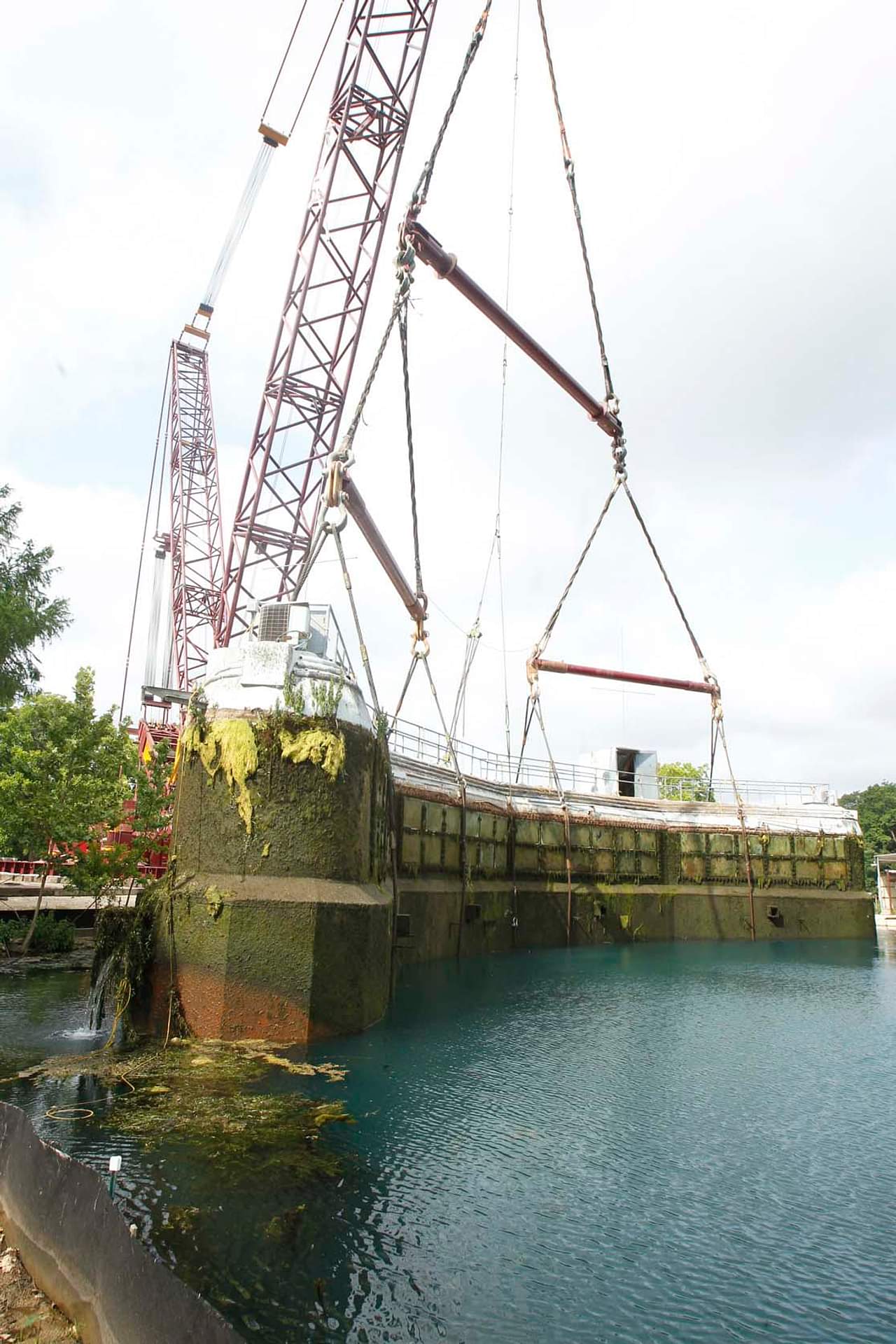News
Sub Theater Lifted from Aquarena Springs Site
Posted: 05/24/2012

Published photo slideshow by MySA (www.mysanantonio.com) of Deep South Crane's heavy lift in Texas.
San Marcos, Tx., (May 24, 2012) - A 467-ton piece of history was hoisted from the headwaters of the San Marcos River early Thursday, bringing the small lake closer to restoration of its natural state but further than ever from memories of its glory days as a tourist attraction.
At a theme park called Aquarena Springs, visitors from the 1950s to the mid-1990s could ride glass-bottom boats across the clear water, play tic-tac-toe against chickens or watch a rabbit play the piano.
But the Submarine Underwater Theatre was the main attraction, and now it's gone. Safe and dry behind its windows, tourists watched "aquamaids" and "witch doctors" perform skits and tricks such as eating and drinking underwater.
And then there was the star of the show: Ralph, the Swimming Pig.
"We didn't have scuba gear," recalled Kevin Valenta, now 51 and a public school teacher, who enjoyed performing at Aquarena Springs from his first day on the job in the summer of 1979 as a freshman at Southwest Texas State University, now Texas State University.
"We used a water hose that was modified for air, so it was a little intimidating at first to get used to breathing through the hose," he said.
Valenta often led Ralph across the water by swimming in front of him with a bottle of milk. The audience could watch Ralph's hooves kicking under water.
Many of those who came to watch a giant crane haul the building from the spring lake Thursday had vivid memories of that pig.
"Ralph wasn't always cooperative," said San Marcos resident Phillip Hicks. "A pig doesn't swim because it wants to. They had to throw him in the water. Sometimes he would get loose and run off."
"Costumed performers would then have to chase him," he said.
Ralph and the aquamaids took their last dives in 1996 after the university acquired the park and decided to convert it to an educational center. The springs are home to endangered species of fish, insects, a salamander and wild rice found nowhere else on Earth. Academics and activists working to protect it from overpumpage of the Edwards Aquifer regarded the park as a tacky distraction.
"We were working on a new show, and so it was a shock for all of us," recalled Robin Ward, an aquamaid in the final production. "Of course I was sad, but I was also energized by the idea of what they were going to do. I had fallen in love with the endangered species and the springs ... and I wanted to be a part of that transition."
Ward ended up working as an aquarium supervisor there, helping develop educational programs.
Valenta also maintained a connection. Teaching in San Marcos schools, he brought his students in for field trips, guided to a tributary creek by a professor in Texas State's aquatic biology program.
"We would use our nets to collect insect larvae, and we could tell the health of the river by what we found," Valenta said.
Education is what Andrew Sansom, executive director of TSU's River Systems Institute, hopes to expand with the restoration of the springs. About 125,000 people already visit each year, many of them school children.
Before the university can build a visitor and education center, it wants to remove all traces of the theme park. The theater was a big and complicated chunk.
"The submarine was built in a time before any environmental regulations, so it contains materials and substances that are potentially harmful to the endangered species," Sansom said. "That's why it's being lifted in one piece."
He said the crane, capable of lifting 1,800 tons, is one of the largest in the country. The removal took more than three hours, with workers using underwater cameras to make sure no colonies of endangered fountain darters or Texas blind salamanders were inside the theater. About 100 tons of water had to be drained from it as it emerged.
"Another smaller structure left on the bottom of the lake from a flood 50 years ago still needs to come out, along with towers that once held aerial cable cars," Sansom said.
One thing can't be removed: nostalgia.
"It's one of those things in the past you wish could go on forever," Valenta said. "But it could be worse. A hotel chain could have come in and wiped everything out. I'm glad they're using it for an education center. It's the next best thing."
Precarious Conditions on the Dock
Posted:05/13/2025
Rail-traveling ship loaders are a familiar sight on the Gulf Coast (and around the world)—and they are essential to the efficient loading of bulk materials. Disruption to the operation of these massive machines directly affects productivity and the bottom line, as represented by one company's experience when wind from a severe storm knocked the machine off its rails, leaving it dangerously close to the edge of the dock.
Reconfigured for a Higher Load
Posted:11/05/2024
During a planned outage, a petrochemical facility in Texas needed to replace a large tower head—measuring 54' L x 30' W x 30' H and weighing 280,000 pounds. Deep South Crane & Rigging selected a strategic setup location for its 2,500-ton VersaCrane TC-36000 to accommodate both the head lift and additional turnaround work. The lift was initially planned at 350,000 pounds, accounting for tray installation.

